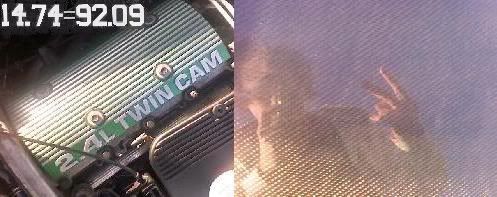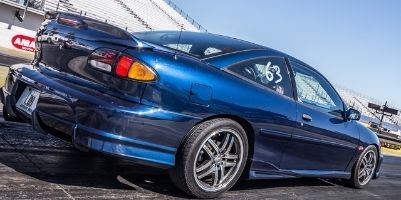This is a local guys graph, he is running a built 2.2 ecotec but badly needs to get a larger exhaust and a larger intercooler. The car is tuned for E85 with HP Tuners on the stock pcm and runs great.
Motor consists of
Wiseco 10:1 pistons
Eagle rods
LZM balance shaft delete
Hand ported head
Supertech valve springs
LSJ valves
Comp Stage 2 cams
Engine was fully balanced
Vulcan turbo manifold
.57 trim garrett turbo
ID1000cc injectors
Racetronix pump
E85
Exhaust was only 2.5 inch piping with some sub par build quality and included a cat converter and some junk muffler.
The intercooler was some small XSPower one.
Last time I spoke with him he told me that the car is going into the shop for a full 3 inch exhaust setup and he is working on getting a new intercooler and maybe even new charge piping. The car will easily be well over 400whp then.


Matter of time before it melts down. Power seems low for e85 and close to 23psi.
 FU Tuning
FU Tuning
It will not melt down. It was clear why power at 22psi was low. Exhaust is way too small and if you saw the intercooler and charge piping you would understand.

also was on a dyno dynamics dyno. People call it the heartbreaker.

I thought it had been discussed that our ecm wasn't capable of e85.


It was discussed. And I explained that it is capable. People just dont understand how the computer works with its sensors. Basically an o2 sensor works by detecting oxygen content of the exhaust, since it does not read fuel content on any level, it does not know that you are running e85, as well it does not know you are running gasoline. all the o2 sensor cares to see is a signal that comes from oxygen in the exhaust. if you are stoich with gasoline the o2 sensor feeds the computer a signal that will also be the same signal when you are stoich with e85. regardless the computer is happy because oxygen content is in the designated zone. the o2 sensor does not see 14.7 parts air to 1 part fuel, it sees that you are producing the proper amount of oxygen in the exhaust, which should be 0 when stoich, and creates a signal to be sent to the computer. Now for ease of the user the computer converts that signal to a number that we can see on screen, which is designated to 14.7 since supposedly we are running gasoline. in computer language that 14.7 means nothing, its just a user friendly value that relates voltage to an air fuel ratio. Because the voltage, sent from the 02 sensor to the computer, for a stoich value, will always be the same regardless of fuel, running e85 will also show up as 14.7 "on screen" to the user. This scares a lot of people because they dont realize what this means. They think that they are extremely lean, but they did not do math correctly and realize that stoich voltage was designated and output of 14.7 to the user on these computers. you have to realize that the output has been scaled to display for gasoline. it is only a display number, it is not the actual signal that causes fuel changes in the computer. when at stoich running e85 in these cars you will see 14.7 on screen but the reality of what is coming out of your exhaust pipe will be an air fuel ratio of 9.7.
The trick to tuning for E85 is simple, you take the injector that you plan on running, and act like it is 1/3 smaller. now you use that number in your injector constant equation.
For example, take a totally stock tune, dont even touch it. leave it alone. The car should be running stoich on gasoline and when you look on your data the computer will display 14.7. now replace the gasoline with E85 and replace the injectors with some that are 1/3 larger and run the car on the very exact same tune. You will notice that the car is running at stoich, screen still displays 14.7 and things are fine. The reason this works is because E85 requires about 1/3 more fuel than gasoline. the bigger injectors compensate for the increased flow while keeping the tune completely stock and the data is still displaying the same values as before. The computer is blind to what fuel is being burnt through it, all it wants to see is oxygen content in the exhaust to be at a safe value. Compensate for the mass flow rate needed and tune accordingly. E85 will work in these cars.
If I need a Works Cited page to source some information and equations I can do MLA or APA maybe even IEEE if necessary (;
jk but for real. Do some Math and Chemistry and understand how the sensors of vehicles work with their computer and you will realize this works.

I will agree a Dyno Dynamics usually is about 18% low. Still I tuned a stock ecotec motor to 314whp on 93 pump gas and 18psi with 2.50 exhaust so that was more my reasoning in saying it was low.
So this is truly probably a 400whp car as it sits on a normal dyno.
Still does not change the fact that I would not attempt e85 on our ecu.
 FU Tuning
FU Tuning
Addicted to meth wrote:I will agree a Dyno Dynamics usually is about 18% low. Still I tuned a stock ecotec motor to 314whp on 93 pump gas and 18psi with 2.50 exhaust so that was more my reasoning in saying it was low.
So this is truly probably a 400whp car as it sits on a normal dyno.
Still does not change the fact that I would not attempt e85 on our ecu.
I agree with all that is said here.. Without the proper tables/modifiers, there is no way to correctly do this. Things can be hacked(like we have been doing for years on this PCM), but some things just are not worth the risk... I hope this lasts, but I would not offer it as viable option for any of my customers....

P&P Tuning
420.5whp / 359.8wtq
Gman
I was interested to see this post, however there are so many things that are not correct about o2 sensors that it gave me a headache trying to read it sorry.

gmanz24 (The Bash Whore) wrote:It will not melt down. It was clear why power at 22psi was low. Exhaust is way too small and if you saw the intercooler and charge piping you would understand.
Your WHP levels aren't low, but seem low because of 2 things.
1 - You ran on the Heartbreaker dyno. Convert to a normal dyno and it's about 18% more. So your 343whp should be 404whp.
2 - That .57 Trim Garret has a flow rate of 50lb/min. Full race says it maxes at 470whp. 22PSI isn't max. Turn up the boost.
E85? Been through this debate many a times. For the hassle, I'd rather run straight 110 instead. Tune it once, and be done with it.
110 octane is available more places that E85 is.
2900 E85 stations in the U.S.
1 in Canada

This car is in Minnesota, e85 is in almost every town. this is not my car either. Also boost would be turned up but the exhaust was killing it. As for so many things wrong with o2 sensors? An o2 sensor reads oxygen in the atmosphere and uses that as comparison to o2 in the exhaust.

-Z Yaaaa- wrote:oh god.. here we go again.

where's my "like" button?

gmanz24 (The Bash Whore) wrote:If I need a Works Cited page to source some information and equations I can do MLA or APA maybe even IEEE if necessary (;
jk but for real. Do some Math and Chemistry and understand how the sensors of vehicles work with their computer and you will realize this works.
Ethanol and Gasoline have different chemical formulas so when they burn they break apart differently. So the amounts of oxygen in the exhaust could be different. Idk the comps of of the top of my head but its something to consider.

Only thing I saw was catalytic converter, 2.5" shotty exhaust and hack job muffler, right there is a possible huge bottleneck, especially at 22 psi... E85 or not, it's obviously working
Addicted to meth wrote:Power seems low for e85 and close to 23psi.
Agreed. I did 323/285 on 2.5" and 16psi, same size turbo.
Erik Nyman wrote:
2 - That .57 Trim Garret has a flow rate of 50lb/min. Full race says it maxes at 470whp. 22PSI isn't max. Turn up the boost.
sounds like the same size turbo as me... the thrust bearing is not a 360 degree thrust bearing. The stock one is like a 270 and it doesnt like above 20psi at all.

TheSundownFire wrote:gmanz24 (The Bash Whore) wrote:If I need a Works Cited page to source some information and equations I can do MLA or APA maybe even IEEE if necessary (;
jk but for real. Do some Math and Chemistry and understand how the sensors of vehicles work with their computer and you will realize this works.
Ethanol and Gasoline have different chemical formulas so when they burn they break apart differently. So the amounts of oxygen in the exhaust could be different. Idk the comps of of the top of my head but its something to consider.
It has been considered when you balance stoichiometric equations. Stoich for one fuel means that there is no o2 found in the burnt products, which also means that with another fuel there is 0 o2 in the burnt product at stoich, so regardless of how they break apart, stoich is stoich. this is the reason you need to flow 1/3 more fuel with e85, that is accounting for the difference in the need for more reactant to create the same stoich burn.
If anyone wants to bring an intelligent argument to the table please do. till now everyone has just been a neigh sayer and has yet to back up reasoning as to why this will not work. If you want to argue that it is unsafe to boost and run e85 than you are also saying that it is unsafe to boost and run gasoline on our computers. Boosting in general on our computers doesnt allow proper fueling and tuning, but till someone validates an argument as to why e85 isnt as safe as gasoline, step down. Our computer has no knowledge as to what fuel is being put through the motor. either does the o2 sensor.
If you were to create a test cell where you burned 5 different types of fuel, and measured that cell with an o2 sensor, at the same mass flow you would see different voltages returned by the sensor. but if you flowed proper amounts of fuel to reach stoich in the cell, the o2 sensor would return the same voltage for each fuel.

It has been considered when you balance stoichiometric equations. Stoich for one fuel means that there is no o2 found in the burnt products -- wrong... the stoich point is different, 14.7:1 is 14.7 parts air so what do you mean there is no air present????
I am not a neighsayor as I work with o2 technology everyday in test cells and give presentations on them... you did not reach to my above comment though......
It is unsafe because the car has no way to alter the stoich point to 9.75:1 which is what it would require for a stoich point here... also GM uses flex fuel sensors to do this and our cars do not have one.. or the coating on the internals to make sure that there is no build up on the valves, like they had problems with on the Volkswagons...
FYI we do have 5 different test cells with different types of fuel and I have seen the results.... you would need a linear equation for 0 volts to 5.51A/F and 5 volts would be 9.79AFR with a linear equation for fueling, also you will never be able to tell the actual concentration of ethanol in the fuel which is what the flex fuel sensor does... the closest thing you could do is run a standalone that would have the provisions for the flex fuel input and multiple fueling maps.. such as Megasquirt....
Questions?

Oh and please use AFR sensor when you are talking about a AFR sensor instead of a switching o2 sensor... there is different technology there, also the flow is slightly different, also takes 30 percent more E85 to make the same power as gas, why are people still trying to do this and not running meth cooling instead?

i have not even mentioned an afr sensor, i am referring to how the oem o2 sensor performs its duties on this vehicle. I never said anything about measuring air, because there is no "air" in the exhaust at stoich. It would contain CO2, H2O, and N2 at stoich in the burnt product correct? Air in theory is 1 part O2 with 3.76 parts N2. Complete stoich combustion with gasoline would yield 0 parts O2 left over in the exhaust . The same goes for complete stoich combustion of e85, 0 parts of O2 would be seen in the exhaust, therefor readings determined by our stock o2 sensor would be the exact same and the same exact voltage would be sent to our pcm. stoich is stoich. if the o2 sees stoich, its sends the same stoich voltage to our computer and no adjustments will be returned by our stock pcm.

jason norwood wrote:It has been considered when you balance stoichiometric equations. Stoich for one fuel means that there is no o2 found in the burnt products -- wrong... the stoich point is different, 14.7:1 is 14.7 parts air so what do you mean there is no air present????
what you just said here is completely wrong. read the section where is says
burnt products when you get an air fuel ratio it comes from the reactants in the equation, so the 14.7 that you refer to is from the 14.7 parts air that were input to the engine with 1 part fuel. this is not numbers found in the product side of the balanced chemical equation. it is a 14.7 air input to 1 part gasoline that yields 0 parts o2 in the exhaust...

ya you are overcomplicating this... I see why no one has replied... burned products? Really? Balanced chemical equation??? You have the engineers here laughing... good luck with this.. lol

Also for those trying to compare their power made vs. this guys, your setups are not the same, comparisons are far from valid. I really should have mentioned that this car was tuned for 10psi previously on the same dyno. The car produced 232whp. The switch to E85 alone on the same boost yielded almost 40 more horsepower. On 10psi and E85 the car made 270whp. This is why many people up in Minnesota run E85 in their cars. E85 is readily available and shows great results. I am not trying to preach that E85 is for everyone, but it is an option. While back in Minnesota I would not be worried about running E85 in my car, but during the school semester when im located in southern illinois, i most likely would not consider it because there is only one e85 pump in the whole area.

jason norwood wrote:ya you are overcomplicating this... I see why no one has replied... burned products? Really? Balanced chemical equation??? You have the engineers here laughing... good luck with this.. lol
how am I over complicating this at all? if all you have to bring to the table is you laughing then how are you credible at all? You really seem to know nothing on this topic and are just trying to laugh it off and justify it with your addition of your so called engineers so you dont look bad. By definition stoichiometry is the balance of the products and reactants in a chemical equation, so if you are laughing at that then you must not know much of what you are talking about. Just because you work somewhere doesnt make you an expert, you are just the mouse turning the wheel. Sorry for the call out but without some information backing up your claims you just seem to be ill informed.
The person that tuned this car was not unfamiliar to the tables available in the pcm, he tuned the car off pump gas before. It wasnt as if the guy showed up with E85 in his tank and say hey tune this. The tuner said it was possible and would work. The only issue he warranted was the lack of resolution in the tables for tuning partial throttle with the 1000cc injectors. But you cant argue that 1000cc injectors are the easiest to tune partial throttle even on pump gas with these vehicles.

Whatever, I dot need to prove anything to you. I talk to over a hundred people a day on race engines. 14.7 parts air to 1 part fuel at stoich so how is that no air... I have taught master techs and hundreds at Uti and wyotec, I need prove nothing to you. We have the most advanced technology in the industry at my work most of which you do not know how to use.. This is another pointless thread to explain. I travel nationally and train thousands of people on this technology a year and know about advancements that you have never heard of. Rethink your logic. I have been trained by the best in the business at my company and have worked with great people like Harold Martin, kinsler fuel injection and many other people. Carry on and I will. Home it when I grenades.. Sorry for the call out but I deal with people like you everyday that make things overly complicated..






















